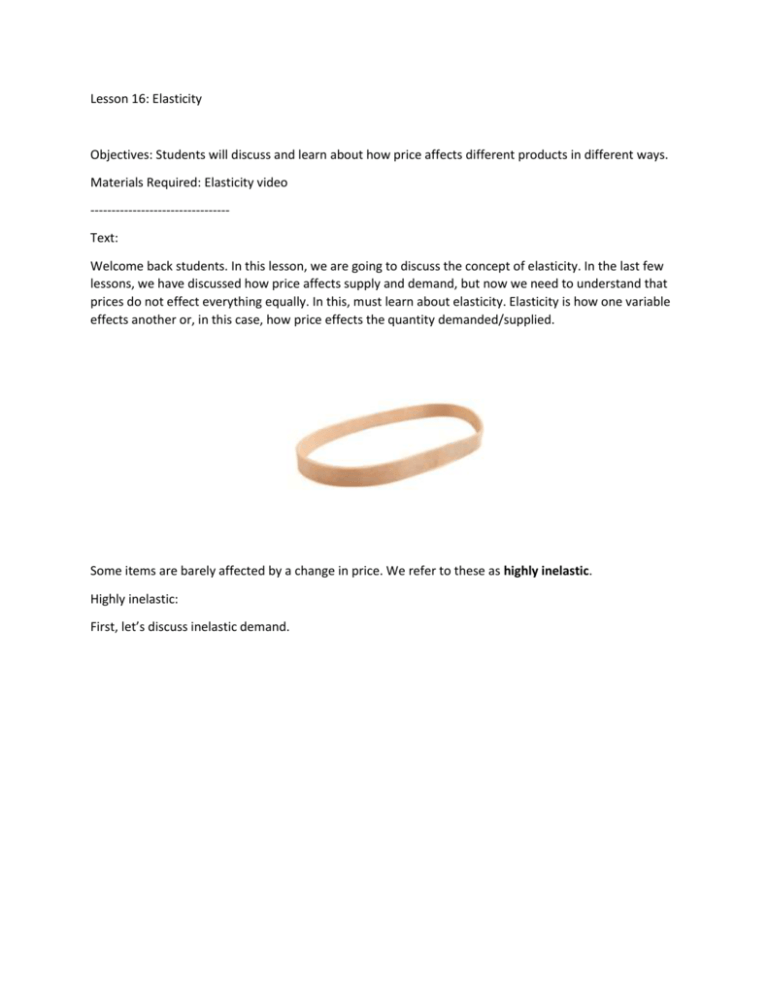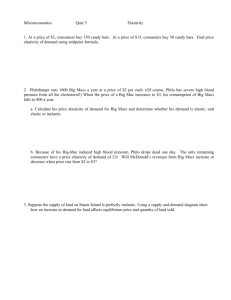Lesson 16: Elasticity Objectives: Students will discuss and learn
advertisement

Lesson 16: Elasticity Objectives: Students will discuss and learn about how price affects different products in different ways. Materials Required: Elasticity video --------------------------------Text: Welcome back students. In this lesson, we are going to discuss the concept of elasticity. In the last few lessons, we have discussed how price affects supply and demand, but now we need to understand that prices do not effect everything equally. In this, must learn about elasticity. Elasticity is how one variable effects another or, in this case, how price effects the quantity demanded/supplied. Some items are barely affected by a change in price. We refer to these as highly inelastic. Highly inelastic: First, let’s discuss inelastic demand. In this graph, you can see that while the two price points are very far apart, the quantity demanded is miniscule. This means that the product in question is barely affected by a change in its price. These are products that tend to be important to people or that people would “pay any price” for, such as: Live-saving medical treatments Addictive substances Ransom for a family member (that got dark fast) In these, you would more than likely be willing to pay just about anything to get what you want. Inelastic supply looks quite similar to demand, only with the curve shifted slightly: Similarly to inelastic demand, inelastic supply also shows how little the production of a good or service was effected by a change in prices. In general reasoning behind this is that the supply simply cannot make more. Here are a few examples of inelastic products: Collectables and antiques Land De’Leorean (cars) Lebron James Gasoline Inelastic goods are things that cannot be made more of. We cannot make more land (or at least it’s very difficult to do so). Old antiques and collectables are rarely increased in supply. Famous people, such as Lebron James and other celebrities, can only exist as that one person. There cannot be more than one of them and no matter how much you change prices or how much you pay, there can only be one Lebron James. Now that we have inelasticity covered, let’s discuss elasticity: First, let’s start with demand, As you can see in this graph, a change in price has severely affected the quantity demanded in this scenario. This is situation that can be best described as “all or nothing”. Either you buy all of the goods at the new price point (P2) or you buy none of the new goods. An example might be if you own a restaurant and you have two companies offering to sell you ketchup in bulk. As a manager who wants to increase your profits, you are going to buy as much as you can from the seller who sells them at the lowest cost. For you, ketchup is a highly elastic product. Many goods on the market are elastic, although rarely do the demand curves slope at this angle. Elasticity of supply is also very similar to demand. In the case of supply, these are goods that can be produced in massive quantities regardless of changes in price. Essentially, this is the situation were a firm—who has been in business for a very long time— can suddenly increase the supply of a good/service due to slight changes in price. It also depends on the product in question. A wheat farmer who suddenly gains more land can produce much more wheat or other farm products with the new land than. However, it may be more difficult for an oil-refinery to produce more with such small changes in price, since they would have to move their production to something else. In many cases, the elasticity of supply is effected by the availability of the resource that is used to make the good or service as well. Closure: With this lesson, Unit 2 is officially finished. What I wanted you to take away from this lesson was the fact that not all products are equal in the market. It’s why you may see your parents fill up on gas even though they were just complaining about rising prices. Not all products are created equal and some are treated differently by the laws of supply and demand. Assignment: Please watch the video “Zero to Hero” and answer the following questions: 1. Is the supply of Hercules elastic or inelastic? 2. Is the demand of Hercules elastic or inelastic? 3. In this video, we saw Hercules-themed products fly off the shelves. Draw a Supply/Demand graph that represents this occurrence. 4. Are Hercules’ products normal or inferior goods?








